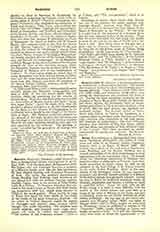

Barocco style (Fr. baroque), a debased application to architecture of Renaissance features. The term is also employed to denote a bad taste in design and ornament generally. Carlo Maderna (1556-1639), Bernini (1598-1680), and Borromini (1599-1667), were among the more famous who practiced this form of art. Among the most prominent examples are the churches of Santa Maria della Vittoria by Maderna, and Santa Agnese, by Borromini, both at Rome. Naples particularly is full of baroque churches, a few of which, like the Gest Nuovo, are dignified and creditable designs. The domical church of Santa Maria della Salute, at Venice, by Longhena, is a majestic edifice in excellent style, and here and there other churches offer exceptions to the then prevalent baseness of architecture. The three Venetian churches, San Barnaba (1749), San Basso (1670), and San Moise, are examples of three different types of the baroque. This style prevailed in church architecture for nearly two centuries. See Renaissance.
THOMAS H. POOLE

